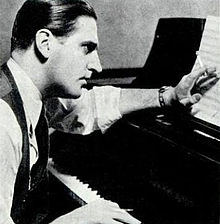Previous Posts: 42-40, 45-43, 48-46, 51-49, 54-52, 57-55, 60-58, 65-61, 70-66, 71-75, 76-80, 81-85, 86-90, 91-95, 96-100
39) Edgar Bergen and Charlie McCarthy
One of the Golden Age of Radio’s most iconic figures was made of wood-Charlie McCarthy. Edgar Bergen was the Ventriloquist behind the world’s most famous dummy. The duo began their work with an appearance on Rudy Valee’s show in 1936 and continued on radio for twenty years on their own program, most famously on the Chase and Sanborn hour. Bergen was both straight man and comic and Charlie was a great radio character in his own right, famously matching wits the great W.C. Fields. In addition to Charlie McCarthy, Bergen introduced characters such as Mortimer Snerd and Effie Klinker to the program’s successful formula. The long term success and enduring popularity of Bergen and McCarthy make the one man comedy an appropriate entry on this list.
38) Alan Reed
Known to generations as Fred Flintstone, long before he cried, “Yabba Dabba Doo!,” Reed made a great impression on radio. He first hit big on Fred Allen’s program as Allen’s Alley regular and poet extraordinaire Falstaff Openshaw. Reed took the characterization if not the character onto other programs including the Jimmy Durante Show and even own series of five minute programs for ABC called Falstaff’s Fable. Reed hit gold in another radio show. His characterization of the scheming Pasquale on Life with Luigi helped to make the show a ratings hit. In addition, Reed was versatile and could turn up anywhere. He could be Chester Riley’s boss on the Life of Riley, a practical joker who decided to get the last laugh with his will on Philip Marlowe, a barkeep on Box 13 or the good friend of a man who fears his housekeeper is a poisoner in an episode of Suspense. Reed remains one of the greatest of all voice characters and his radio work showcases this amazing legacy.
37) Meredith Willson
 On shows ranging from Maxwell’s Good News program in the late 1930s to the Burns and Allen in the late 40s, and the Big Show in the 1950, Willson portrayed an on-air character who was a little stupid and a bit of a bore. This merely shows what a great actor Willson was. Willson remains one of the underappreciated musical masters of the era. As an orchestra leader and composer, his arrangement were often brilliant and thoughtful. In late 1938, he sought opinions from a wide variety of people asking them if all the music in the world were to be destroyed, what one composition might they save and then had his orchestra play the piece. Willson’s arrangement of music for special occassions and his takes on popular songs were often breathtaking. On the Big Show, he introduced, “May the Good Lord Bless and Keep You” as the closing anthem to The Big Show, sung by all of the stars line by line in what would be a classy and often duplicated closure. The song itself became a standard that would be recorded by a wide variety of actors from Tennessee Ernie Ford to Kate Smith and Johnny Mathis. Willson continued to be a standout as a composer and band leader while at the same time possessing solid comic timing as an actor.
On shows ranging from Maxwell’s Good News program in the late 1930s to the Burns and Allen in the late 40s, and the Big Show in the 1950, Willson portrayed an on-air character who was a little stupid and a bit of a bore. This merely shows what a great actor Willson was. Willson remains one of the underappreciated musical masters of the era. As an orchestra leader and composer, his arrangement were often brilliant and thoughtful. In late 1938, he sought opinions from a wide variety of people asking them if all the music in the world were to be destroyed, what one composition might they save and then had his orchestra play the piece. Willson’s arrangement of music for special occassions and his takes on popular songs were often breathtaking. On the Big Show, he introduced, “May the Good Lord Bless and Keep You” as the closing anthem to The Big Show, sung by all of the stars line by line in what would be a classy and often duplicated closure. The song itself became a standard that would be recorded by a wide variety of actors from Tennessee Ernie Ford to Kate Smith and Johnny Mathis. Willson continued to be a standout as a composer and band leader while at the same time possessing solid comic timing as an actor.
Willson also wrote the standard, “It’s Beginning to Look a Lot Like Christmas.” In addition to music, Willson tried his hand fiction, writing a novel that was previewed on an episode of the Big Show in 1952 and after radio he wrote the music and co-wrote the story for the Broadway Musical, “The Music Man.”
If you enjoyed this post, you can have new posts about Detective stories and the golden age of radio and television delivered automatically to your Kindle.

7 comments for “Radio’s Most Essential People Countdown: #39-#37”